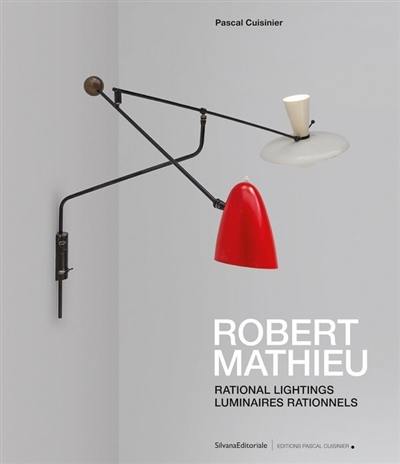
Paru le 09/02/2023 | Relié sous jaquette 262 pages
Tout public
préface Jean-Jacques Aillagon
Luminaire rationnel
Né en 1921, Robert Mathieu suit une formation de tourneur sur bronze à l'école Boulle mais il inventera quelques-uns des luminaires les plus exceptionnels de sa génération. Après l'urgence de la reconstruction d'après-guerre se remet en place, en France, toute une économie de l'habitat autour de la grande tradition française de la décoration et du mobilier. Une jeune génération issue des grandes écoles s'en empare et met en place les bases de ce que l'on appelle aujourd'hui le design soit la création au service de la production en série. Robert Mathieu les accompagne de sa créativité infinie et de sa technicité parfaite. Il pense des luminaires articulés pour éclairer chaque fonction de l'appartement moderne. Il manipule l'asymétrie comme personne et ses systèmes de double balancier restent uniques au monde.
Cette première monographie sur Robert Mathieu est issue de la recherche de Pascal Cuisinier qui s'intéresse au design français d'après-guerre depuis le début des années 2000. À la fois scientifique et esthétique, ce travail entend faire découvrir l'oeuvre de Robert Mathieu tant aux néophytes qu'aux collectionneurs plus avertis et éclairer un peu plus cette période faste qu'ont vécu les arts décoratifs en France durant les Trente Glorieuses.
Rational lighting
Robert Mathieu (born 1921) studied metal-turning in bronze at the École Boulle school of applied arts and crafts, but would later go on to invent some of the most exceptional lighting designs of his times. Following the urgent rebuilding phase in France after the end of World War II, a whole new housing-based economy emerged, built on the great French traditions of interior design and home furnishing. A new generation, fresh from the most prestigious schools, was quick to grasp the opportunities offered by this economy, laying the foundations of what we now call « design » - namely, devising goods for mass production. Robert Mathieu was part of this generation, bringing his boundless creativity and perfectly mastered technical skills to the table. He designed articulated lamps for every task in the modern home, putting to good use his unparalleled ability in tackling asymmetry and creating double-counterweighted systems unlike anything seen elsewhere.
This first monograph on Robert Mathieu is the fruit of research carried out by Pascal Cuisinier who, since the early 2000s, has been an aficionado of French post-World War II design. Focusing on the academic and the aesthetic aspects in equal measure, this study aims to introduce the work of Robert Mathieu to both newcomers and informed collectors, and to shed some light on the period of renewed prosperity experienced by the decorative arts in France during the thirty-year economic expansion known as the Trente Glorieuses.
Pascal Cuisinier
Architecte de formation et philosophe de l'art, Pascal Cuisinier se dédie très tôt aux arts décoratifs français. Il est spécialiste du design des années 1950 et 1960, expertise qu'il développe dans un premier temps aux Puces de Saint-Ouen puis rue de Seine, dans le quartier de Saint-Germain-des-Prés, où il ouvre une galerie en 2011. Il consacre alors toute son énergie à la défense des « premiers designers français », cette génération d'artistes et de décorateurs née entre 1925 et 1930, formée à l'École nationale supérieure des Arts Décoratifs ou à l'École Camondo et qui ouvre ses agences au lendemain de la seconde guerre mondiale.
Alain Richard, Pierre Paulin, Jacques Biny, Joseph-André Motte, Janine Abraham et Dirk Jan Rol ou encore Pierre Guariche ont donc fait l'objet d'expositions rétrospectives et de monographies dans les murs de la galerie ou dans les salons internationaux. Cet amour de la recherche et des beaux livres a donc conduit Pascal Cuisinier à ouvrir sa propre maison d'édition éponyme. Robert Mathieu, luminaires rationnels est donc le premier ouvrage qu'il y publie, en coédition avec Silvana Editoriale.
Pascal Cuisinier
Soon after completing his studies in Architecture and Philosoph-ycof art, Pascal Cuisinier turned his attention to the French decorative arts. He specialises in 1950s and 1960s design, having honed his knowledge in the flea market at the Puces de Saint-Ouen and then in the galleries and antique shops of the Rue de Seine, in the Saint-Germain-des-Prés district, where he opened a gallery in 2011. Since then, he has devoted all his efforts to promoting the « first French designers » - the generation of artists and decorators born between 1925 and 1930, who trained at the École nationale supérieure des Arts Décoratifs or at École Camondo and who began their careers in the years just after World War II.
Pascal Cuisinier has mounted retrospective or solo exhibitions on Alain Richard, Pierre Paulin, Jacques Biny, Joseph-André Motte, Janine Abraham and Dirk Jan Rol, and Pierre Guariche, among others, either at his own gallery or at international fairs. Inspired by his love of research and of fine books, Pascal Cuisinier set up his eponymous publishing house, which has collaborated with Silvana Editoriale to publish this first work : Robert Mathieu, rational lighting.